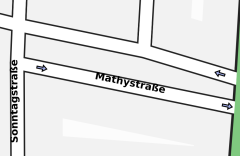Key:oneway: Difference between revisions
(→values: fixed typo) |
(copied from the access page) |
||
| Line 24: | Line 24: | ||
If bicycles are allowed to ride in the opposite direction tag them with one of the values of {{Tag|cycleway||opposite*}}. |
If bicycles are allowed to ride in the opposite direction tag them with one of the values of {{Tag|cycleway||opposite*}}. |
||
== |
== Values == |
||
* {{Tag|oneway||yes}} (discouraged alternative: "true", "1") |
* {{Tag|oneway||yes}} (discouraged alternative: "true", "1") |
||
* {{Tag|oneway||no}} (discouraged alternative: "false", "0") |
* {{Tag|oneway||no}} (discouraged alternative: "false", "0") |
||
| Line 37: | Line 36: | ||
== Sub keys == |
== Sub keys == |
||
* oneway can be used in conjunction with vehicle type. I.e. {{Tag|oneway:moped||no}} for a one-way streets where mopeds are allowed to drive in the opposite direction. Bicycles ({{Tag|oneway:bicycle||no}}) are handled specially and {{Tag|cycleway||opposite/opposite_lane/opposite_track}} needs to be added for compatibility: (See [[Key:access]] for sub-values) |
* oneway can be used in conjunction with vehicle type. I.e. {{Tag|oneway:moped||no}} for a one-way streets where mopeds are allowed to drive in the opposite direction. Bicycles ({{Tag|oneway:bicycle||no}}) are handled specially and {{Tag|cycleway||opposite/opposite_lane/opposite_track}} needs to be added for compatibility: (See [[Key:access]] for sub-values) |
||
== Translation for routing == |
|||
The oneway tag can be translated (for routing purposes) to this generic system as follows (oneway restrictions presumably do not apply to pedestrians): |
|||
* {{Tag|oneway||yes}} to {{Tag|vehicle|:=backward||no}} |
|||
* {{Tag|oneway||-1}} to {{Tag|vehicle|:=forward||no}} |
|||
== Rendering == |
== Rendering == |
||
Revision as of 19:24, 23 June 2011
| Description |
|---|
| Oneway streets are streets where you are only allowed to drive in one direction. |
| Group: Restrictions |
| Used on these elements |
| Documented values: 4 |
| Useful combination |
|
| Status: de facto |
| Tools for this tag |
|
The oneway tag is used to indicate the access restriction on the way. This means that this tag should be used when this way can only be used in one direction.
Take a look on the access=* page to add more detailed restrictions.
How to Map
In addition to any highway=* tags on the road the tag oneway=yes is added. Make sure the way points in the same direction as the oneway goes. (To show the ways direction in JOSM activate it in the general or layer preferences, Potlatch has an arrow in the bottom left of the screen which shows the direction of the way.)
If the road is only a oneway road in certain parts, you'll have to split up the way in several ways.
Some tags (such as junction=roundabout, highway=motorway and others) imply oneway=yes. You don't need to add a oneway tag, because they are oneway by default. If a tag implies an oneway value, this is noted on the implying tag's wiki page. There is ongoing discussion about implicit oneways, so applying a tag is not wrong.
If for some reason the oneway goes not in the direction of the way, the fix in most cases is to turn the way around ("reverse way" tool in the editors, JOSM and Potlatch have menu options for this), and apply oneway=yes. If in a rare case the direction of the way cannot be changed, you can instead tag it as oneway=-1.
If bicycles are allowed to ride in the opposite direction tag them with one of the values of cycleway=opposite*.
Values
- oneway=yes (discouraged alternative: "true", "1")
- oneway=no (discouraged alternative: "false", "0")
- oneway=-1 (discouraged alternative: "reverse")
The semantics of any other value is undefined. The oneway-tag may be completely ignored as illegal or may be handled as oneway=yes.
- oneway=reversible is presently used to indicate a road that is one-way at certain times of day, and one-way in the other direction at other times.
- One can also use oneway:hour_on=* and oneway:hour_off=*. A more flexible solution for time-dependent oneways is using oneway:[[Key:<opening_hours value>|<opening_hours value>]]=* as proposed by Extended conditions for access tags. But this doesn't work in cases where there is no schedule and the roadway direction is set based on current traffic flows on a day-to-day basis.
Sub keys
- oneway can be used in conjunction with vehicle type. I.e. oneway:moped=no for a one-way streets where mopeds are allowed to drive in the opposite direction. Bicycles (oneway:bicycle=no) are handled specially and cycleway=opposite/opposite_lane/opposite_track needs to be added for compatibility: (See Key:access for sub-values)
Translation for routing
The oneway tag can be translated (for routing purposes) to this generic system as follows (oneway restrictions presumably do not apply to pedestrians):
Rendering
Osmarender renders little blue and grey arrows at the beginning and end of a oneway street.
Mapnik renders little blue arrows at the beginning and repeats these arrows until the end of a oneway street.
See also
- access=* - General access restriction key.
